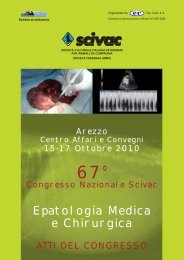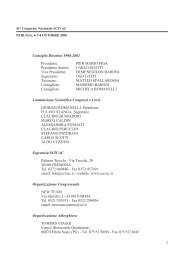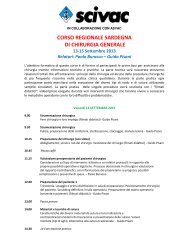58° Congresso Nazionale SCIVAC: Oncologia veterinaria
58° Congresso Nazionale SCIVAC: Oncologia veterinaria
58° Congresso Nazionale SCIVAC: Oncologia veterinaria
Create successful ePaper yourself
Turn your PDF publications into a flip-book with our unique Google optimized e-Paper software.
58° <strong>Congresso</strong> <strong>Nazionale</strong> <strong>SCIVAC</strong> • Milano, 7-9 Marzo 2008 • <strong>Oncologia</strong> <strong>veterinaria</strong> - Alle soglie del III Millennio<br />
contributes therefore to both the mechanism of action and significantly to the<br />
toxicity profile of the drug. The dose for dogs is reported to be 1.13 mg/kg,<br />
infused intravenously diluted to 0.6 mg/ml after extensive pretreatment with<br />
antihistamines and corticosteroids to prevent anaphylactic reaction. The dose<br />
in cats has been reported to be 5 mg/kg, Cats are much less sensitive to<br />
the anaphylactoid effects of paclitaxel. The pretreatment protocol involves 5<br />
days of oral prednisolone at 1 mg/kg, oral diphenhyrdamine 1 mg/kg and<br />
oral famotidine 0.5 mg/kg once daily for 5 days as a preparatory regimen.<br />
After parenteral administration, paclitaxel is metabolized in the liver by the<br />
cytochrome P450 system. It is avidly bound to proteins and less than 25% of<br />
the administered dose is recovered in urine as unchanged drug. Paclitaxel has<br />
a wide volume of distribution and biphasic plasma clearance, with half-lives<br />
of 1-6 hours and 5-17 hours for initial and terminal elimination phases, respectively.<br />
Hepatic metabolism is extensive, with high concentrations of the<br />
drug in bile.<br />
Docetaxel is an semisynthetic analog of paclitaxel that has been used in<br />
Europe and is reportedly less anaphylactogenic than the original compound.<br />
Docetaxel has been administered at 30 mg/m 2 IV.<br />
A new formulation of paclitaxel in under development in Europe with an<br />
indication for veterinary application. This agent is solublized without the use<br />
of cremophore, and thus should be much less toxic. The dose of this investigational<br />
agent is 175 mg/m 2 IV over 15-30 minutes every 21 days. Studies of<br />
this agent are ongoing but very promising response rates have been noted in<br />
the pilot studies.<br />
Toxicity<br />
Dose limiting toxicities include myelosuppression, hypersensitivity reactions,<br />
arrhythmias, and neuropathy in humans. The hypersensitivity reaction requires<br />
pretreatment prophylaxis with corticosteroids, diphenhydramine and an<br />
H2-receptor antagonist. Hypersensitivity reactions seen include head shaking,<br />
pruritus, edema, erythema, hypotension, bronchospasm, and bradycardia. Anorexia,<br />
nausea and vomiting can be seen. Hypersensitivity reactions may be dependent<br />
on rate of administration, and slow infusiton is recommended.<br />
Indications<br />
Therapeutic indications in veterinary medicine are still being explored, but<br />
it appears that paclitaxel may be useful for treatment of a variety of carcinomas<br />
in dogs and cats, including mammary and pulmonary carcinomas.<br />
73
















